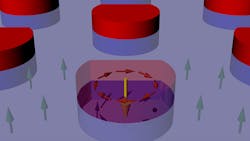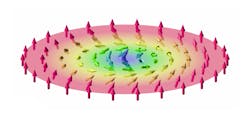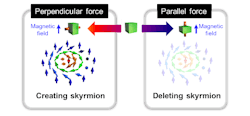New Research Pushes Skyrmions Closer to Magnetic Memory Devices
Three research projects, recently published in the journal Nature Communications, have unveiled new breakthroughs in the study of skyrmions—small magnetic spin patterns in thin films. It has been widely speculated that skyrmions could form the basis of future high-density memory devices. The new research has addressed several major disadvantages with the technology, namely the extreme conditions under which skyrmions are formed and the stability of the spin patterns after they have been created.
In most magnetic materials, the magnetic forces within each atom are all pointed in the same direction. Under extreme conditions, however, some materials can develop tiny regions of reversed magnetism, surrounded by whirling spin patterns or skyrmions. Using magnetic, thermal, or electrical stimuli, these spin patterns can be formed in extremely small areas—smaller than other magnetic storage devices, including hard-disk drives.
Once formed, skyrmions have proved to be highly stable and not easily corrupted. Most scientists agree that their stability is related to the energy required to realign the spinning magnetic forces. The swirling atoms—which are rotating in the opposite direction as the magnetic forces in the thin film—have to overcome an energy barrier to align themselves with the rest of the atoms. For this unique characteristic, researchers are looking to use skyrmions as addressable bits to store information in memory and logic devices, where the state of the bit is encoded by the existence or non-existence of the skyrmion.
About two years ago, researchers in Hamburg, Germany, observed skyrmions for the first time, finding that they appeared in certain magnetic materials, such as manganese silicon (MnSi). At the same time, the researchers could only manipulate them at extremely low temperatures: 4° Kelvin or -452.47° Fahrenheit. In addition, the researchers were forced to use an external magnetic field to stabilize the spin patterns.
New research has addressed these technical issues. Based at the National Institute of Standards and Technology (NIST) in the United States, the first research team developed a method for inducing skyrmions at room temperature and without an external magnetic field. To achieve these results, the team patterned asymmetric magnetic nanodots on a thin film made of cobalt and palladium.
The second research team, based out of the KTH Royal Institute of Technology in Sweden was able to form skyrmions under a nanocontact in which a spin-polarized current had been injected into the material. The current provides spin-torque to the skyrmion, improving its overall stability. The skyrmion can be stabilized by the spinning motion around its own axis—similar to how a spinning top stabilizes itself.
"Since there is an insatiable appetite for storing information, for uses such as mobile phones, computers, and particularly online, nano-skyrmions are very interesting as an information carrier," says Johan Åkerman, a guest professor at the KTH Institute. "They can be made extremely small and are easily programmed using spin-polarized currents like in MRAM (magnetoresistive random-access memory).”
Another research team, working out of the RIKEN Center for Emergent Matter in Science in Japan, demonstrated a completely new method for creating and erasing skyrmions. The team used a small mechanical force to manipulate the skyrmions. While the team was forced to create skyrmions at extremely low temperatures, the hope is that using a mechanical force will severely reduce the amount of energy consumed by a skyrmion-based memory device.
According to the leader of the RIKEN team, Yoshihiro Iwasa, “we may be able to fabricate devices in which skyrmions are created and deleted by a small mechanical force. This could be an inexpensive and low-energy-consuming way to create new low-cost memory devices.”
About the Author
James Morra
Senior Editor
James Morra is the senior editor for Electronic Design, covering the semiconductor industry and new technology trends, with a focus on power electronics and power management. He also reports on the business behind electrical engineering, including the electronics supply chain. He joined Electronic Design in 2015 and is based in Chicago, Illinois.



